Japanese Musings 2.3: Riding the Kamioka-sen
Japan is a strange place. In contrast to my native Britain, Japan is either dead flat or straight up and down. In my entire two years working there, I never once saw anything remotely resembling rolling countryside.
Where I lived in Ōsawano it was flat. Perfectly flat. Ideal country for riding a bike which was useful since I was regularly crashing, abandoning or having towed away my car, (see ‘
Japanese Musings III: The Thin Blue Line’), forcing me to rely on two wheels for much of the time. But flat as Ōsawano may have been, travel just a kilometre or two up Route 41 and suddenly cycling was all but a dream unless you’re one of those mad souls who enjoys competing for the King of the Mountains jersey in a bike race.
But steep hills and mountains, whilst not conducive to brilliant bicycling, are bloody beautiful and there were few things that I enjoyed doing more on a weekend than heading up the gorgeous Jinzu Valley into the heart of the Japan Alps in my Mattmobile, (when it was running), or, (when it was not and often when it was too), on the Kamioka-sen.[1]
 Sasazu Station
Sasazu Station
The Kamioka-sen did not run through Ōsawano itself. Instead, my town was served by Sasazu station [2] on the main JR Takayama-sen (1920-34) which starts in Gifu-shi, pierces and winds its way through the Japan Alps before finally ending up in Toyama-shi. The four-hour trip, (best broken with a stop off in the beautiful museum city of Takayama halfway), comes highly recommended. I did the journey soon after my arrival in the country, taking one of the Hida Limited Express services which come equipped with wide-windowed observation coaches, all the better to sample the stunning scenery with.
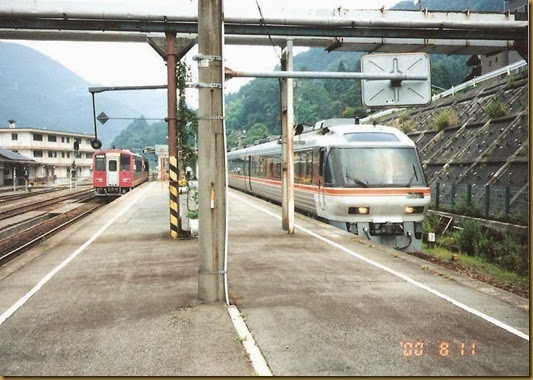 The Hida Limited Express and a stopper service at Inotani
The Hida Limited Express and a stopper service at Inotani
However, such elite services as the Hida Limited Express never stopped at Sasazu, it being a most minor star on the constellation of the JR network indeed, and so instead, when heading towards the Kamioka-sen, I would take the one-car stopper service along with farmers, housewives on their weekly shop and depressed schoolkids still in their uniforms despite the fact that it was the weekend.
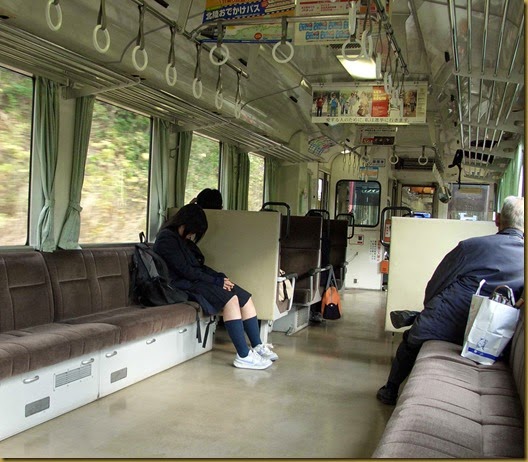 Not quite the Orient Express: on board the stopper to Inotani
Not quite the Orient Express: on board the stopper to Inotani
I would take the stopper as far as Inotani, a nondescript yet spectacularly-located village, (barely more than a hamlet actually), some 5km or so south of Sasazu. All the trains, including the Limited Expresses stopped at Inotani, not because of the place itself which, as I have already hinted, hardly warranted any station at all, but instead because it formed the spot where the JR West network met the JR Central network and because it was a junction, the place where the railcar that ploughed the Kamioka-sen stood waiting ready to take you on a trip along its little branchline.
 The Kamioka-sen train waiting at Inotani
The Kamioka-sen train waiting at Inotani
JR is, (or was, it’s been chopped up and privatised these days), the national rail company of Japan, but unlike in the UK and other European countries, the nationalisation process was never very complete and across Japan there are scores of tiny – and not-so tiny – railway companies which survive alongside the national big brother. One of the most famous for example, is the Hankyu Railway which operates 139km of track in the Kansai Region whilst in Toyama-ken the Dentetsu Station next to the JR one is the hub of an extensive network of lines, (just under 100km of track), across the eastern half of the ken[3] run by the Toyama Chihō Railway (commonly called the Chitetsu). The Kamioka-sen was also private, but one of the much smaller operators, owning and running just the one line, the 19.9km route from Inotani to Hida-onsen, its rolling stock consisting of but two railcars and two freight locomotives.
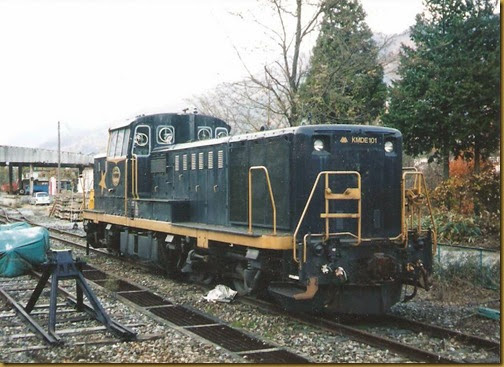 One of the freight locos
One of the freight locos
I loved the Kamioka-sen. You’d cross the tracks and get in the friendly red, white and blue railcar with its tea ceremony area in the middle (I kid you not!), and then settle down for the ride, a slow trundle through some incredible Alpine scenery, punctuated by several lengthy tunnels.
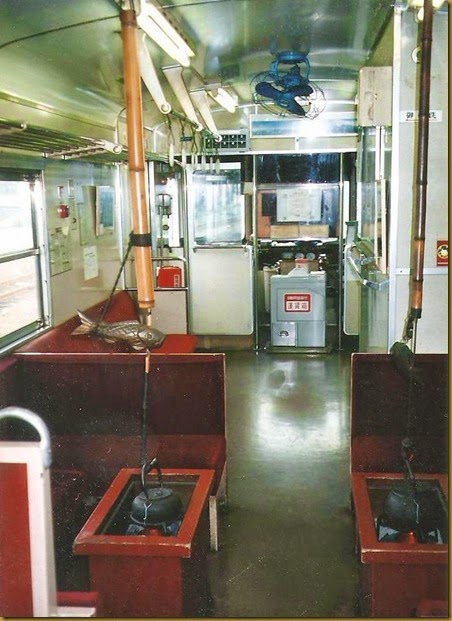 Inside the Kamioka-sen train with the tea ceremony facilities between seats
Inside the Kamioka-sen train with the tea ceremony facilities between seats
There were seven stops – actually, there were originally eight, but one closed – and on the platform of each one was a tiny wooden shrine housing a deity, one of the Shichi Fukujin (Seven Lucky Gods) of Shintōism, who include such luminaries as Hotei (the Laughing Buddha) and Ebisu (the fisherman god who gives his name to the beer).[4] That was what I loved so much about it; the personal, local touches; which other railway company pays for wooden shrines to protects its trains, provides tea ceremony facilities on board and produces an annual calendar featuring scenes from the line? It was a modern version of the golden age of rail travel which in Britain was the Victorian Era, when every area had its own railway company and every railway company was rooted in the area that it served. To find such a line and ethos still alive in late 20th century Japan was a joy to behold, for in Britain the Kamioka-sen – which could never have made money since it had few passengers and due to its long tunnels and many bridges, must be inordinately expensive to maintain – would have been closed years ago, its best hopes being turned into a footpath or, if very lucky, preserved by enthusiasts. But in Japan in 2002 its rusty wheels kept turning and I was one was glad to have travelled by them.
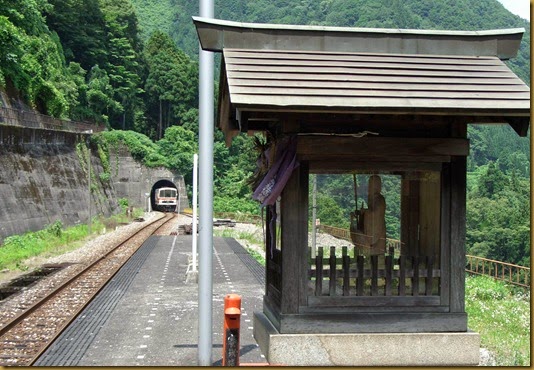 The Shintō shrine on Mozumi Station
The Shintō shrine on Mozumi Station
But railways, no matter how quaint, full of character and scenic, are only as good as the places that they serve and here too the Kamioka-sen was a winner. Kamioka-cho, (technically part of Gifu-ken’s Hida-shi, although a more un-city-like place you can’t imagine), was well worth taking a trip to even without its funky little train. Kamioka is a pretty, quiet little mountain town nestled in the folds of the Jinzu Valley, the river running through its heart. The town was best served by Hida Kamioka Station, an elevated stop at the end of a high railway bridge traversing the western end of the town centre. I recall alighting one Saturday and descending the steps into a large and lively matsuri (festival) with floats and food stalls, (deep-friend octopus balls – yum!) lining the streets. Even out of the festival season though, there was plenty of stuff worth seeing here. Kamioka Castle, a 1970 reconstruction of a Sengoku Era fortress with samurai armour and swords on display inside is well worth checking out and once you’ve been there, then there’s always the weird and wonderful Kamioka Observatory Visitors’ Centre.
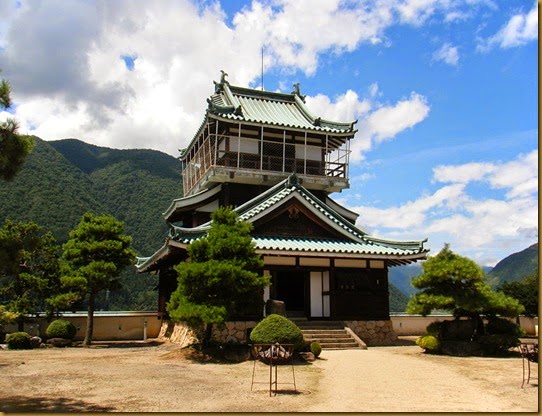 Kamioka Castle
Kamioka Castle
Kamioka Observatory really is the town’s X-Factor. Just north of the town itself, it is located deep inside the old Mozumi Mine which dates back to 710AD and was used to extract zinc, lead, silver and ore.[5] Indeed, the presence of mines in Kamioka is the main reason why speculators were prompted to build such an expensive railway (it is reputedly 60% tunnels and bridges), to such an out-of-the-way spot, since ore needs shifting and nothing can shift it better than rail. Now, that is true anywhere in the world, but it is particularly true in Japan, a country with virtually no mineral resources, (during my entire two years there, Kamioka was the only place that I came across where I saw any evidence of any kind of mining whatsoever). But anyway, when the Mozumi Mine closed in the early 1980s, a neutrino physics experimental lab was constructed in the disused chambers which aimed to discover more about the breakdown of protons. Now, having run away from Physics screaming after scraping through my GCSE Combined Science aged sixteen, I’m far from sure what all of that means, but the vast chamber filled with pure water, its walls covered by large bulb-like plates looked like something out of a science fiction film and since its director, one Masatoshi Koshiba won the Nobel Prize for Physics in 2001 for his work there, then I’m guessing it’s important.
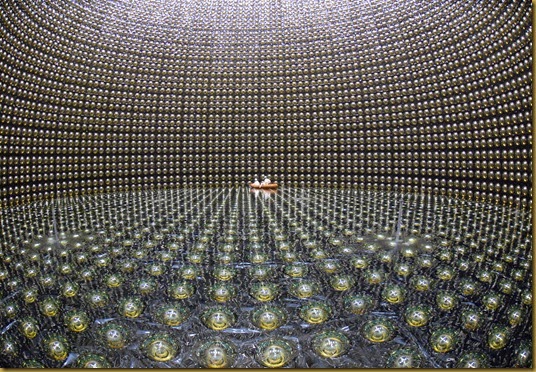 Inside the Kamioka Observatory: “No Mr. Bond, I expect you to die!”
Inside the Kamioka Observatory: “No Mr. Bond, I expect you to die!”
But for me the real drawcard was not down the old Mozumi Mine nor in the town itself, but instead at the very end of the railway, at Hida Onsen Station, (although alas, there was no onsen in sight here), which housed the most glorious little tearoom in all Japan and was as idiosyncratic as the rest of the line, with an old bus parked on the platform as a waiting room. Regularly would I take the train there and then enjoy delicate ham sandwiches with a pot of tea whilst reading a classic novel or adding another chapter to my latest story before then walking along the street beside the track, stopping at the exquisite Shintō shrine en route to the next stop, Kamioka Ohashi, from where I’d catch the next train back. Simple pleasures perhaps, but aren’t they always the best.
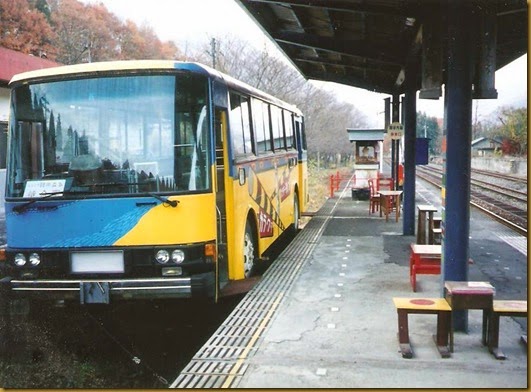 Hida Onsen Station with the bus waiting room
Hida Onsen Station with the bus waiting room
Postscript – 2013
Researching this piece eleven years after I last travelled on the line, I learnt to my dismay that the Kamioka-sen finally bowed to the inevitable and ceased operating in 2006. Since the last of the Kamioka mines closed in 2001, I’m guessing that the two events are related since the passenger traffic was never enough to justify its survival (80% of revenues came from freight traffic). However, it seems that the line has not died completely for its tracks have now been taken over by ‘MTB Gattan Go!’, an activity centre where one can hire a bicycle specially adapted to run on railway tracks and cycle the entire route. So, who knows, perhaps I shall ride the rails of the Kamioka-sen again one day in the future…?
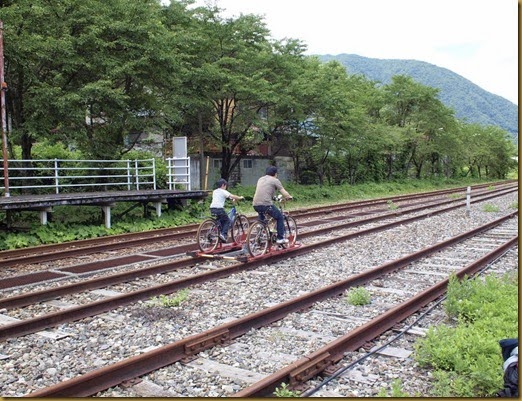 MTB Gattan Go!
MTB Gattan Go!
1 Sen = line, as in railway line.
2 Sasazu was one of the several villages that were combined to form Osawano-machi.
3 Ken = county or prefecture.
4 See ‘Japanese Musings IV: Nihon no Shokyu’ for more details.
5 Cadmium leaking into the Jinzu from the mine during World War II caused an outbreak of a mystery sickness which killed many locals called Itai-itai, (lit. “It hurts! It hurts!”).
Technorati Tags:
travel,
blog,
japanese musings,
japan,
toyama-ken,
gifu-ken,
osawano,
inotani,
kamioka,
kamioka-sen,
kamioka castle,
mtb gattan go,
railways,
trains,
takayama-sen,
hida express,
sasazu,
jinzu,
itai itai,
Masatoshi Koshiba,
mozumi












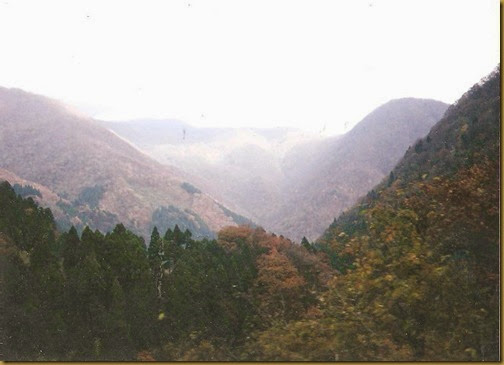
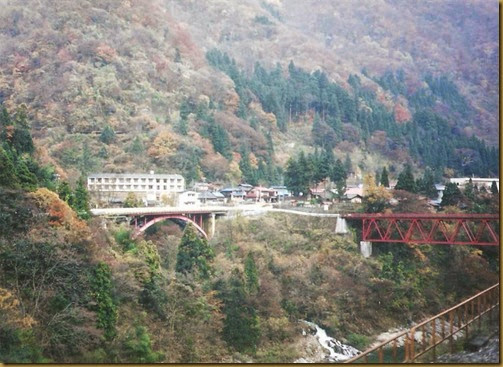
No comments:
Post a Comment